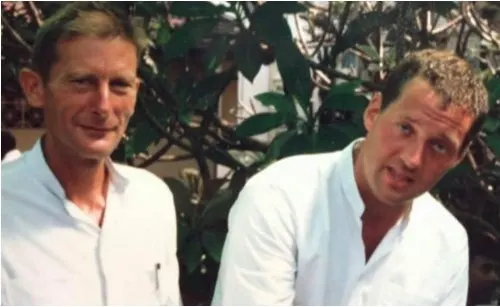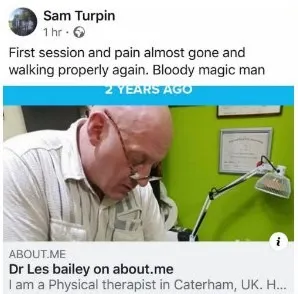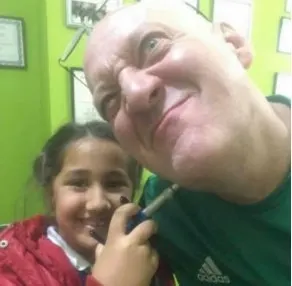About Dr Les Bailey
About Dr Les Bailey Senior Consultant at the Back and Joint Pain Centre, Caterham.
Dr Les Bailey began his career in Biomechanic therapies at age 16 . He had left school with two CSE's and a sheer determination to study Osteopathy.
He mischievously told the College he had the necessary 4 A levels to get in, and that he was 18, and so began his first of 4 years training in soft tissue manipulation, and turned out to gain A grades throughout his course.
After his first year, he went to work at the tyringham naturopathic clinic, a big old stately home used as a residential clinic, in the remedial massage department. He gained much experience there, being immersed into homoeopathic medicine, acupuncture, biomechanics therapy, and many modalities of treatment.

He completed his Osteopathy 3 years some time later, before being awarded an Osteopathy teaching diploma at the Northern school of Osteopath's, enabling him to teach. He puts this accolade on his mentor, professor Michael Nightingale, who mentored him through the 4 years.
Les calls Michael Nightingale a genius, who gave him so much more than standard Osteopathy training. After completing his osteopathic training, he went on to work alongside very experienced chiropractors, both traditional chiropractic and Mc Timoney School, learning their skills, as he taught them his.
He had various clinics across the Uk ,and , was Bedfordshire police osteopath.
He opened a sports/remedial massage College, where he taught over 2000 students, as well as the body shops own therapists.He also taught at the Northern school of Osteopath's in the 90s.
He studied (see qualifications page) Musculoskeletal acupuncture, Laser therapy, and ultrasound, not forgetting what he is best known for, orthotics (see orthotics page).He has over 40 years experience, but still remains humorous, putting his patients at ease.
He is well known for his hatred of the general osteopathic council, along with many other "old school" osteopaths, and left in a wave of exodus from the council by many members in 2004 (see links). The general feeling is that this "quango" are destroying the profession and diluting it's teaching.
They charge its members £500 a year, bully them with the power they have, inhibit the teaching of real Osteopathy in the colleges, and in their introduction, broke many promises such as marketing Osteopathy and making the public aware of what it is/does. From the beginning there was an "old boy" atmosphere of who got the highest positions, all from the same stable (Osteopathy used to be split into 5 different associations) sadly nothing will change.
Dr Les Bailey practices under the title Biomechanics Therapist, which really best describes the myriad of skills he offers, rather than be confined into one discipline.
Aside from biomechanics therapist Dr Les Bailey, the clinic also offers traditional acupuncture, and an amazing beauty therapist visits once a month.


Dr Les Baileys philosophy on treatment (from an article he wrote for newly qualified osteopaths) Relevant to patients too!
I would like to share with newly qualified (or not so newly qualified ) osteopaths, and chiropractors, a philosophy, I have built up over 40 years in practice, namely, of what gives you a winning edge to fast results, and patients that are hugely impressed with the speed at which you can get them out of pain.
Before you read further, I understand that the "proof is in the pudding" and I would guide you to read the around 600 patient testimonials (there are many more not included!) to the work I do and how I get these results.
Cut and paste these links and read, before you proceed to read the rest of this article.
https://flickr.com/photos/185127027@N07/sets/72157711524539307
Far be it for me to show you these testimonials to "boast" but to demonstrate how using the philosophy I freely share with you, will help you to become a practitioner that gets the same fast results my former patients speak of in these testimonials.
I am considered by many to be somewhat of a "renegade" in the profession, and despite my qualifications, resigned from the general osteopathic council in 2004 .
This explains why:
https://eprnews.com/dr-les-bailey-general-osteopathic-council-the-truth-432373/
Hoping you have digested the essence of the testimonials, and are now curious to find out my philosophy, read on and digest .
Firstly, get out of the mindset that "I'm an osteopath or chiropractor, and therefore, this is the philosophy I work under" way of thinking.
When I first qualified as an osteopath, the first thing I wanted to know was, what do the chiropractors know that I don't (?), so I made it my business to find out, and learn these differences.Let's look at the differences between Osteopathy and chiropractic.
When we look at when Osteopathy was created by Andrew Taylor Still, it was the tail end of the Wild West! I was watching a cowboy film the other night, and it hit me, just how long ago this actually was, and it's timeframe in history.
Palmer was a student of Still, and disagreed with Still's philosophy that we are healing our patient by restoring blood flow, or "the rule of the artery" as it was put then. Still taught restoration of movement in the spine and joints to restore faulty blood flow. Palmer believed we cure by freeing the nerve, using different methods than Still, to realign the spine, and went off and created chiropractic. Both men believed all health came from their own disciplines, which, is a bit far fetched in our vastly more knowledgeable age of medicine. However, what they taught, certainly has its valid points, even beyond mere Musculoskeletal healing. But, no man or method is an island in the field of medicine, and all systems have strengths and weaknesses compared to others, and this is why the good practitioner keeps an open mind to other schools of thought.
The truth of the matter is, that both Still and Palmer were right, and an approach with both disciplines in mind is needed to give our patients the very best we can.
To be excellent at what we do requires us to keep an open mind, learn other disciplines, and use the techniques taught in those to fill in the weaknesses in our own systems. My first port of call was to work with some eminent old school chiropractors, and we had a learning system where we would swap techniques, day by day, on different areas of the Musculoskeletal system.
I did this with a conventional chiropractor, a Mc Timoney chiropractor, and a chiropractor that worked almost solely with the activator tool. We all discovered that we "filled gaps" in our own systems, and became far more versatile and effective at what we did.
For example, the Mc Timoney way of working the pelvis and sacro iliac, combined with one or two Osteopathic methods, gives us an amazingly effective way to treat this area.The chiropractic way of treating the neck, with a smattering of osteopathic technique (and a huge serving of gentleness), is far safer and superior than osteopathic methods alone. The chiropractic activator is an amazing tool that I use on nearly every patient, and illustrates the perfect union of both disciplines to achieve rapid healing for the patient.
The activator is superb for realignment of the pelvis and vertebrae, as well as the TMJ , but I will add one thing that I find vital. In most cases, the activator is a brilliant tool to fine tune what we have done, by firstly restoring movement in the area using osteopathic technique, and then using the activator to add the finishing touches. This gives our patient the best of both Osteopathy and chiropractic teachings, and creates a perfect fusion of both methods.
However, the activator as a stand-alone method is highly useful in cases where manipulation would be contraindicated, and I have achieved brilliant results on patients who could not be treated by either conventional Osteopathy or chiropractic. In particular, post-operative cases, intervertebral disc issues, ank spon, and osteoporosis, to name a few.
There are many old school Osteopathic techniques that are no longer taught, and we have the grey suits at the General Osteopathic Council to thank for this, and, from what I have come to believe, is the same with the chiropractic council. An example of this is the brilliantly safe lumbar lift, where we can free the lumbar spine safely and swiftly, and I have used this even where there are disc bulges, and furthermore, it has saved a good many from surgery (and amazed a few orthopaedic surgeons upon re scanning the spine, to find the bulges gone). This is no longer taught at the schools, incase the osteopath hurts their own back performing it, and then sues the college! Done properly, this technique uses leverage on our part and does not strain the back at all.
I find a good many practitioners in all branches of medicine, ours included, who over complicate things. My original mentor, Dr Michael Nightingale, a brilliant osteopath, had a saying he instilled into me, namely "look for the horses before you look for the zebras". I feel this is self explanatory, but I see a good amount of patients, where other practitioners have failed because they have not seen what is glaringly obvious, and treated it thus. It is all very commendable to know the highly complicated and academic approaches, but 41 years of practice has taught me that keeping to old fashioned diagnosis and treatment, where indicated safe to do so, and further investigation is not needed, is far more efficacious than going off into an academic mind warp, and getting nowhere in our efforts.Rule one is, simply get the patient out of the pain they are paying you to rid them of, before you disappear into a whole host of classical and complicated work. This advanced approach is far better left until after you have cleared up as much of the original pain the patient came to you for, as is possible to do.
After this is achieved, then is the time to restore movement and realignment to the whole body to prevent reoccurrence. Another weakness I have been most unhappy about in the teaching of both Osteopathy and chiropractic, and sorely affects the long term resolution of the patients pain, is that the biomechanics of the feet, and the employment of orthotics, are still not being taught at college level. A great example of this, is reoccurring sacro iliac instability. I am not talking about a one-off injury, but those patients who have been to every discipline trying to seek a cure for their sacro iliac, that gives constant problems on and off.
The feet, and the way they function, absolutely governs the sacro iliac joint, and correcting the faulty foot posture, stops this cycle almost immediately. To not understand this, is to not be complete in your discipline, and you learning this valuable lesson, will give you patients who think you are next to a God! You will have cleared up years of pain in one swoop and those patients go on to refer people to you for years to come.
Copy and paste this article I wrote on orthotics and the sacro iliac joint to read further into this.
Orthotics must be highly accurate and individually prescribed to achieve this properly. Why this is not taught at colleges of Osteopathy and chiropractic is beyond believable, and something needs to be done to address this huge shortcoming.
There are many different disciplines out there, that you can learn parts from that will make you far more effective in your work. It is up to you to keep an open mind, be humble with what you don't know, or where there are weaknesses in your original training, and go out there and learn them.
I have even learned elements of homoeopathic medicine to assist my work, and went on to pioneer the use of local arnica injections, to use in place of cortisone, a method that has now caught on in the medical world,is highly successful, and more importantly, incredibly safe .
Learn musculoskeletal acupuncture, as this is a superb way to ease muscle spasm prior to manipulation, and unlike massage, the muscle will not fight back and end up tighter than when you began.
Another modality not taught at colleges, is therapeutic ultrasound, which, when used properly, is an amazing tool I would not be without, and has given me an incredible treatment factor that I have used over 35 years. If practitioners care to email me, I will gladly pass on an invaluable way of using ultrasound which will see you never without it in your practice again. This was a method that was taught to me by a former pathologist turned osteopath many years ago, and is quite simple.
I use laser too, but I may add the machines are very costly for the amount you will use them. However, laser is a useful modality, if finances allow. Finally I would like to say, I am happy to pass knowledge on to other practitioners, and take pride in teaching young osteopaths, or chiropractors, different things. I do not do this for profit, as I ask no fee, but to make sure a lot of old school Osteopathy is passed on before the ruling bodies completely dilute Osteopathy into the history books.
I am also happy to teach any of the other techniques I talk about in this article.
Be available to your patients, at least, by phone 7 days a week. People worry if in pain, and your reassurance can mean a lot to them.
Finally, don't put treatment out of reach of people by charging high fees for first consultations, or by charging extra to see you Sunday or public holidays , as they are desperate and in pain,and many cannot afford this. Don't make them pay for X amount of treatments up front, as many cannot afford this.
Be a good and kind practitioner, and your practice will grow and grow, as will your reputation as a good and caring practitioner, and not a money grabbing one .











